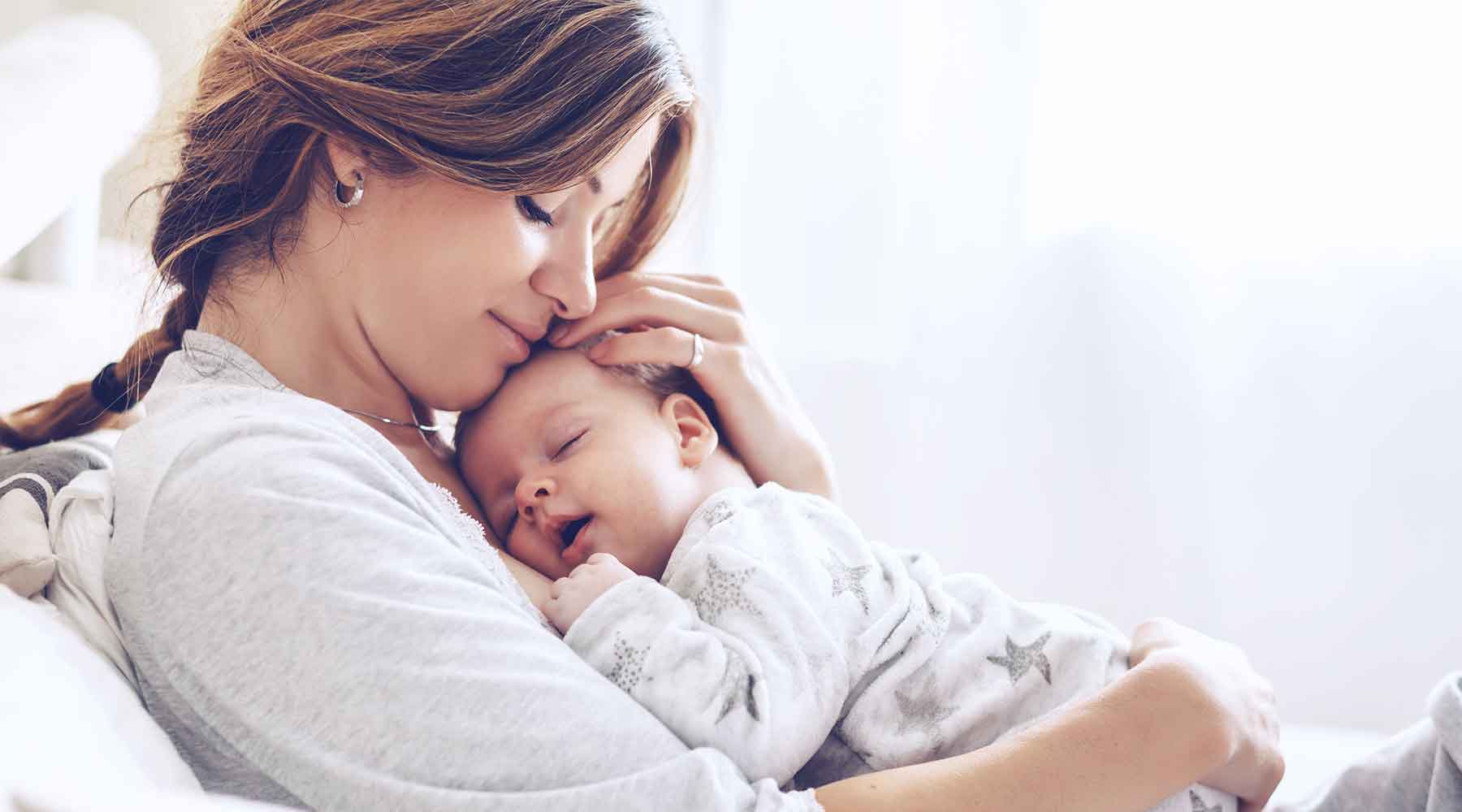
Baby sleep - what makes it so special?
Babies and toddlers sleep a lot – because sleep is extremely important for early childhood development and health. Learn here what makes baby sleep so special and how you can help newborns establish a stable sleep rhythm as quickly as possible.
Table of contents
- Baby sleep – The special features
- How long do babies sleep?
- The right sleeping environment for babies
- 5 tips for a peaceful baby sleep
- Not recommended...
- Conclusion
1. Baby sleep – The special features
Good sleep is especially essential for babies because during sleep the immune system is strengthened, the brain processes the impressions of the day and important hormones for growth and child development are released.
How much a baby sleeps varies greatly from child to child. In principle, babies' sleep differs in many ways from that of older children and adolescents. Not only the Total sleep time is significantly longer at 16-18 hours, the distribution of sleep stages is also different. A baby spends about half of its sleep in the so-called REM (Rapid Eye Movement) sleep, i.e. Almost four times as much as in adolescence and adulthood. This is because REM sleep is a fundamental component of the development of the child's brain, and the brain develops very dynamically, especially in the first months of life.
In addition to the longer Total sleep time Babies' sleep is also significantly more fragmented. This means that babies sleep in several periods, spread throughout the day and night. The frequent waking phases are completely normal in the first few months of life and should not be a cause for concern for parents.

2. How long do babies sleep?
While newborns sleep a lot in the first months of life, the Sleep needs and the composition of sleep phases with increasing age and maturity. Below, we show you the characteristics of each month of life.
0 – 3 months
During the first three months of life, babies sleep a total of 16–18 hours per day. Sleep is fragmented, and the baby sleeps throughout the day and night, with regular waking phases. During this time, the baby's sleep rhythm is just beginning to develop. The high proportion of REM sleep indicates the dynamic development of the brain during this early phase of life.
3 – 6 months
Babies develop a more stable day-night rhythm. There is an increase in nighttime sleep and a decrease in daytime sleep. Most children at this age fall asleep at roughly the same time each evening and wake up at roughly the same time each night and each morning. By about 6 months of age, a longer, continuous sleep period develops. Some babies still require one or more feedings at night.
6 – 9 months
The sleep rhythm becomes increasingly stable and the Sleep cycles become longer. Some babies actually sleep through the night at this age – for a full six to eight hours. However, this still means parents have to be prepared for their child to wake up during the night. The proportion of REM sleep has already decreased significantly at this age and, after eight months, accounts for about one-third of total sleep time.
1 year
The total sleep time after one year is now approximately 14 hours. The individual sleep and wake phases become increasingly longer, and the majority of sleep occurs at night, supplemented by 2-3 short naps during the day.
1 – 2 years
Sleep needs continue to decrease, reaching approximately 12 to 13 hours after the age of 2. Toddlers get the majority of their sleep during the night. Naps become more pronounced, and there are more frequent sleep periods per day than two. By 18 months, almost all children are sleeping only once a day, and some can even do without naps altogether by 24 months. Here, too, there are significant differences from child to child.
It should be remembered at every age that every baby and toddler is unique and that even within a family the Children’s sleep behavior can develop differently. This is no reason to worry and usually everything settles down again after a while.

3. The right sleeping environment for babies
The right Sleeping environment is important for safe and healthy sleep for babies and there are a few things to consider when choosing sleeping positions and bed environment.
Supine position – The recommended Sleeping position
It is recommended that babies be placed on their back to sleep in the first few months of life. Side positioning is not recommended because they may roll over onto their stomach while sleeping. Prone positioning is generally strongly discouraged in the first one to three months of life. Sleep lab studies have shown that babies respond less well to disturbances when they are placed on their stomachs than when they are placed on their backs. This is also the stage of life when the risk of sudden infant death syndrome is greatest. Therefore, babies should only sleep on their stomachs when they are strong enough to roll over onto their backs on their own and can also lift and hold their head up independently.

The bed environment for babies
A baby's bed should be furnished rather sparsely. Make sure the baby's head isn't obscured by a blanket or pillow. Here are a few tips.
- Use sleeping bags instead of duvets
- If a duvet is used, it should be tucked under the mattress at the foot of the bed and secured so that the child is only covered up to the chest.
- The mattress in the baby bed should not be too soft
- Babies and toddlers under 3 years of age do not need a pillow
- The bed environment should be safe and there should be no cords or ribbons within the child's reach

Temperature & air quality
- The room temperature should be around 16 to 18 degrees Celsius for babies and toddlers when sleeping
- A bodysuit/undershirt and pajamas are usually sufficient clothing. If it's too hot, you can even leave one item off.
- Hats and head coverings should be avoided in bed.
- The baby bed should not be placed directly next to the heater or in direct sunlight. Hot water bottles, heating pads, “nests”, furs and thick duvets should also be avoided in the baby’s bed
- The bedroom should be well ventilated and it should be ensured that no smoking takes place in the bedroom

4. 5 tips for a peaceful baby sleep
#1 A fixed daily routine
Just as with adults, a fixed daily routine and a day/evening routine have a positive effect on sleep for babies and toddlers. Therefore, you should always make sure to put your child to bed at the same time so that they can get used to a regular sleep can get used to fixed times.
#2 Get some rest early
One hour before bedtime, excessive play and activity should be avoided. Loud noises and excessive activity can disrupt your baby's preparation for sleep. A short trip in the stroller or car can help encourage sleep.
#3 Introduce rituals
Habits are especially important for babies and toddlers. This way, they learn what to expect in the evening and can prepare for it. The best bedtime routine for little ones depends on the individual child. However, there are some popular rituals that have proven very effective:
- Bathe: For many children, a bath can have a very calming effect. The warm water also has a positive effect on body temperature and can promote sleep. Gently drying and applying moisturizer can also have a relaxing effect on the child and prepare them for a restful sleep.
- Put on pajamas: A cozy pajama set can give the child the signal that sleep is approaching and put them in the mood to fall asleep.
- Darken the room: Darkening the room is a very effective ritual for preparing babies and toddlers for sleep. A dark and quiet sleeping environment also promotes sleep.
- Lullaby: Repetitive and already familiar to the baby Melodies can have a calming effect and promote sleep. The melody of a music box can sometimes work wonders.
#4 Don’t play at night
If a baby wakes up at night, this waking period should not be used as playtime. There's a risk that the baby will become accustomed to nighttime activity. Quiet conversations and soothing gestures will show the child that it's actually bedtime.
Babies are familiar with many monotonous sounds from the womb. Therefore, soothing sounds can help promote sleep. The sound of the ocean, the hum of airplanes, or so-called White noise sounds Babies like to fall asleep.
In our

5. Not recommended...
In addition to the many classic bedtime rituals, there are also things that should be avoided early on. Babies are often carried around, in the Stroller driven around or on the chest placeduntil they They have fallen asleep and then placed in their bed while still asleep. However, if you get your baby used to it, they will soon demand these sleep aids again and again. A change of habit later is possible, but it can be very stressful for both parents and child.
Also recommended is the Do not delay falling asleep. Babies who are overtired or overstimulated have a harder time falling asleep. Therefore, it's advisable to pay particular attention to signs of tiredness in babies. A common sign of sleep deprivation is crying. Babies and toddlers who cry frequently and for long periods of time (so-called "cry babies") often also have a sleep deprivation. They don't get enough sleep during the day, which makes them overtired and overstimulated, and they have difficulty relaxing.
6. Conclusion
-
Adequate sleep is essential for babies' development and well-being.
-
Babies' sleep habits and sleep needs change during the first 24 months of life. This is completely normal and shouldn't worry parents.
-
The right sleeping environment promotes falling asleep and staying asleep.
-
Routines and calming rituals can help you fall asleep.
Best wishes and see you soon!




Leave a comment
This site is protected by hCaptcha and the hCaptcha Privacy Policy and Terms of Service apply.